Distillation Pharmaceutical Engineering Introduction
Distillation is a process of separating the liquid components or substances from a liquid mixture by selective boiling and condensation at different places. Distillation may result in complete separation or it may be a partial separation that increases the concentration of selected components of the mixture.
The distillation process involves two steps:
- Conversion of liquid into vapour phase.
- Condensation of liquid at another place to recover the liquid.
The feed liquid is called as distill and the condensed liquid is known as distillate or condensate.
If one component is volatile and the other is nonvolatile, it is possible to separate volatile components from nonvolatile components by distillation (complete separation). In the case of two volatile components mixture, the highly volatile component gets vapourized at a lower temperature and then it is taken for condensation. In this case, the condensate contains a small amount of low volatile component (partial separation).
Difference between distillation and evaporation:
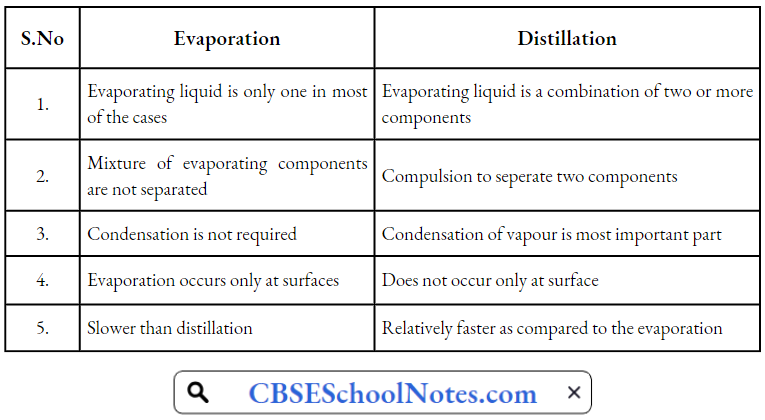
Distillation Pharmaceutical Engineering Applications
Makes up about 95% of all current industrial separation processes. It has been used in chemical industries, pharmaceutical and food industries, environmental technologies and petroleum refineries.
- The most common use is after a chemical reaction where we obtain some products. Distillation is used to separate the desired product from the rest obtaining a high purity product.
- Examples of the most important applications in, the food industry are. concentrating essential oils and flavours. The deodorization of fats and oils or in alcohol distillation.
- Some pharmaceutical processes based on the concentration of antibiotics are also related with distillation columns.
- Distillation is the main part of petroleum refineries. The crude oil which contains a . complex mixture of hydrocarbons is pumped into a huge distillation column to be separated by different temperatures.
- The solvents used for extraction from crude drugs need to be recovered to prevent contamination of the environment. So they are recovered by using distillation techniques.
- It can be used in the purification of solvents.
- It is used to purify the products which are obtained by extraction.
- It is used to recover expensive solvents used during the extraction process
Distillation Pharmaceutical Engineering Different Methods
- Simple distillation
- Flash distillation
- Fractional distillation
- Azeotropic distillation
- Distillation under reduced pressure
- Steam distillation
- Molecular distillation
- Falling Film Molecular Still Or Wiped Film Molecular Still
- Centrifugal Molecular Still
1. Simple Distillation:
It is also called differential distillation. Simple distillation is a procedure by which two liquids with different boiling points can be separated. Simple distillation (the procedure outlined below) can be used effectively to separate liquids that have at least a degree difference in their boiling points.
As the liquid being distilled is heated, the vapours that form will be richest in the component of the mixture that boils at the lowest temperature.
- Purified compounds will boil, and thus turn into vapours, over a relatively small temperature range (2 or 3°C); by carefully watching the temperature in the distillation flask, it is possible to affect a reasonably good separation.
- As distillation progresses, the concentration of the lowest boiling component will steadily decrease.
- Eventually, the temperature within the apparatus will begin to change; a pure compound is no longer being distilled.
- The temperature will continue to increase until the boiling point of the next-lowest-boiling compound is approached.
- When the temperature again stabilizes, another pure fraction of the distillate can be collected. This fraction of distillate will be primarily the compound that boils at the second lowest temperature.
- This process can be repeated until all the fractions of the original mixture have been separated.
Simple Distillation Principle:
Liquid boils when its vapour pressure equals atmospheric pressure. Simple distillation is conducted at its boiling point. If the difference in volatility is greater then the separation becomes more easy and effective. When the liquid mixture is boiled it forms the vapour of volatile components. Then this vapour is condensed in another part of the distillation apparatus.
Simple Distillation Apparatus:
The construction of a simple distillation apparatus. It consists of a distillation flask with a side arm sloping downwards. The condenser is fitted into side arm using a cork. The condenser is usually a water condenser, that is jacketed for the circulation of water. The condenser is connected to the receiver flask using an adapter.
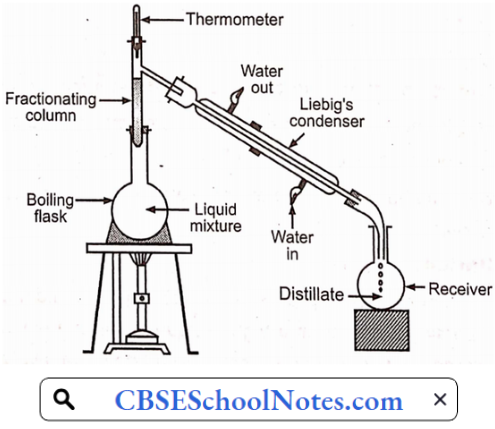
Simple Distillation Procedure:
- Fill the distillation flask:
- The flask should filled less than two-thirds because there needs to be sufficient clearance above the surface of the liquid so that when boiling starts the liquid should not enter into the condenser, which can affect the purity of the distillate.
- Boiling chips should be placed in the distillation flask for two reasons: they will prevent superheating of the liquid being distilled and they will cause a more controlled boil, eliminating the possibility that the liquid in the distillation flask will bump into the condenser.
- Heat the distillation flask:
- Heat the distillation flask slowly until the liquid begins to boil. Vapours will begin to rise through the neck of the distillation flask.
- As the vapours pass through the condenser, they will condense and drip into the collection receiver.
- An appropriate rate of distillation is approximately 20 drops per minute.
- Distillation must occur slowly enough that all the vapours condense to liquid in the condenser.
- Many organic compounds are flammable and if vapours pass through the condenser without condensing, they may ignite as they come in contact with the heat source..
- (Note: All fractions of the distillate should be saved until it is shown that the desired compound has been effectively separated by distillation.)
- Remove the heat source from the distillation flask:
- Distillation flask before all of the liquid is vaporized.
- If all of the liquid is distilled away, there is a danger that peroxides, which can ignite or explode, may be present in the residue left behind.
- Also, when all of the liquid has evaporated, the temperature of the glass of the filtration flask will rise very rapidly, possibly igniting whatever vapours may still be present in the distillation flask.
Simple Distillation Applications:
- It is used for the preparation of distilled water and water for injection.
- Many volatile oils and aromatic waters are prepared by simple distillation.
- It is used in the purification of organic solvents.
- The concentration of liquid separates nonvolatile solids from volatile liquids such as alcohol and ether.
2. Flash Distillation
Flash distillation is defined as a process in which an entire liquid mixture is suddenly vaporized (flash) by passing a feed from a high-pressure zone to a low-pressure zone.
- This process is frequently carried out as a continuous process and does not involve rectification.
- Flash distillation (sometimes called “equilibrium distillation”) is a single-stage separation technique.
- A liquid mixture feed is pumped through a heater to raise the temperature and enthalpy of the mixture.
- It then flows through a valve and the pressure is reduced, causing the liquid to partially vapourize. Once the mixture enters a enough big volume (The “flash drum’) the liquid and vapour separate.
- Because the vapour and liquid are in such close contact until the “flash” occurs the product liquid and vapour phases approach equilibrium.
Flash Distillation Principle:
- When a hot liquid mixture is allowed to enter from a high-pressure zone to a low-pressure zone, the entire mixture suddenly vaporizes.
- During this process, the chamber gets cooled because of a sudden drop in boiling point.
- Because of this cooling, the less volatile component condenses and is converted into liquid whereas the more volatile component remains in the vapour phase.
- The process requires the equilibrium to be reached and therefore the liquid and vapour are held in contact with each other for some time and then are separated.
- The liquid fraction is collected separately. The vapours are further condensed and collected.
Flash Distillation Construction and Working:
It consists of a pump which is connected to a feed reservoir. The pump helps in pumping the feed into a heating chamber which consists of a suitable heating mechanism. The other end of the pipe is directly introduced into the vapour liquid separator through a pressure-reducing valve.
A vapour outlet is provided at the top of the separator and a liquid outlet at the bottom. The feed is pumped through a heater at a certain pressure. The liquid gets heated and enters the vapour liquid separator through a pressure-reducing valve.

Due to the pressure drop the liquid flashes, which further enhances the vapourization process and there is flash boiling of the liquid mixture.
- But this sudden vaporization induces cooling.
- The vapour phase molecules of high boiling fraction get condensed while the low boiling fraction remains as vapour.
- The mixture is allowed to remain for a sufficient time so that vapour and liquid portions separate and achieve equilibrium.
- The liquid is collected from the bottom, while vapour from the top side is condensed further to achieve the second component in a liquid state.
- It can be used in the continuous mode by providing continuous feeding. The operating conditions can be adjusted in such a way that the amount of feed exactly equals the amount of material removed.
Flash Distillation Uses:
- Flash distillation is used for separating components, which boil at widely different temperatures.
- It is widely used in the petroleum industry for refining crude oil.
Flash Distillation Advantages:
- It is used for obtaining multicomponent systems of a narrow boiling range.
- It can be used in continuous mode.
Flash Distillation Disadvantages:
- Flash distillation is not suitable for the separation of components having comparable volatility.
- It is not suitable if the separated components are needed in pure quality.
3. Fractional Distillation
Fractional distillation is a process in which the vapourisation of a liquid mixture gives rise to a mixture of constituents from which the desired one is separated. This method is also called as rectification because a part of the vapour is condensed and returned as a liquid. This method is used to separate miscible volatile liquids whose boiling points are close.
Fractional Distillation Principle:
Fractional distillation is a mass transfer process involving counter-current diffusion of the component at each equilibrium stage.
- When a liquid mixture is distilled, the partial condensation of the vapour occurs at the fractionating column.
- In the column, the ascending vapour from the still is allowed to come in contact with the condensing vapour returning to the still.
- This results in the enrichment of the vapour with the more volatile component.
- By condensing the vapour and reheating the liquid repeatedly, equilibrium between liquid and vapour is set up at each stage, which ultimately results in the separation of the more volatile component.
Fractional Distillation Construction:
The apparatus is assembled as in The mixture is put into the round bottom flask along with a few anti-bumping granules (or a Teflon-coated magnetic stirrer bar if using magnetic stirring), and the fractionating column is fitted into the top. The fractional distillation column is set up with the heat source at the bottom of the still pot. As the distance from the still pot increases, a temperature gradient is formed in the column; it is coolest at the top and hottest at the bottom.

Fractional Distillation Working:
The process starts with taking a mixture of two liquids X and Y of which X is more volatile than Y. The mixture is taken in the distilling flask and is heated. The temperature rises slowly and the mixture begins boiling. Vapours will start forming. The vapours formed consist of more volatile component X with a small amount of less volatile component Y. Vapours start travelling in the fractionating column. Condensation of vapours of the less volatile liquid Y will start before those of the more volatile liquid X.
So by time, the vapours rising in the fractionating column will be more of X and the liquid flowing down will consist of liquid Y. The process of distillation and condensation is repeated. As a result of successive distillations, the vapours of more volatile component X will reach at the top, from there they are taken into the condenser and finally the substance is transferred to the container. Similarly, after a series of distillations, the remaining liquid in the distillation flask gets enriched in components with higher boiling points
Fractional Distillation Uses:
- One of the important uses of fractional distillation is to separate the crude oil into its various components such as gasoline, kerosene oil, diesel oil, paraffin wax, and liberating oil.
- Fractional distillation is also used for the purification of water.
- Water contains many dissolved impurities; these can be removed by this process.
- It is also used for separating acetone and water.
- Industrial use of fractional distillation is in petroleum refineries, chemical plants, natural gas processing and the separation of pure gases from mixture of gases.
- It has other industrial uses as it is used for the purification and separation of many organic compounds.
Fractional Distillation Disadvantage:
Fractional distillation cannot be used for miscible liquids.
4. Distillation under Reduced Pressure
Vacuum distillation is also called as distillation under reduced pressure. This technique is used for purifying or separating thermally unstable liquid compounds that decompose at their normal boiling points.
Distillation under Reduced Pressure Principle:
The lowering of pressure on the surface of a liquid (by using a vacuum) lowers its boiling point. As a result of this, a liquid can be boiled and distilled, without any decomposition, at a temperature much below its normal boiling point
Distillation under Reduced Pressure Equipment:
Distillation under reduced pressure or vacuum is carried out in a specially designed glass apparatus. A two-necked ‘Claisen’s flask’ is used, the main neck of which is fitted with a long capillary tube (capillary tube avoids bumping) and the side neck is fitted with a thermometer. The side tube is connected to a condenser carrying a receiver at the other end. The receiver is attached to a vacuum pump to reduce the pressure. The pressure is measured with the help of a manometer.
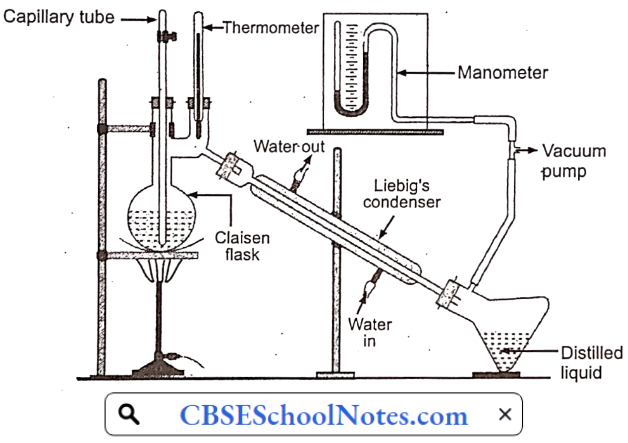
Distillation under Reduced Pressure Procedure:
The liquid is to be distilled is filled in the flask (one-half to two-thirds the volume of the flask). Small pieces of porcelain are added to the liquid to facilitate distillation and prevent bumping.
The capillary tube and thermometer are placed in the respective necks of the flask. The required vacuum is applied. The contents are heated gradually. The temperature rises and liquid gets vaporized rapidly due to the vacuum. The vapour passes through the condenser. The condensate is collected in the receiver.
Distillation under Reduced Pressure Advantages:
- The advantages of distillation under reduced pressure are:
- The compounds that decompose on heating to their boiling points can be purified by distillation under reduced pressure. This is because, at the reduced pressure, a liquid would boil at a temperature much below its normal boiling point.
- Distillation under reduced pressure is more fuel-economical as it makes the liquid boil at temperatures well below the normal boiling point.
- The fractions are distilled off at relatively lower temperatures, cracking or decomposition being thus largely avoided.
- In some crude drugs drying gives compact or dense residue which is undesirable. This method can produce a light porous mass due to the sudden evaporation of liquid.
Distillation under Reduced Pressure Disadvantages:
- In vacuum distillation, persistent foaming occurs.
- Not suitable for preparation of semisolid or solid extract.
5. Steam Distillation
Steam distillation is a method in which steam is used for distillation and it is used for
- The separation of high boiling liquids from non-volatile impurities.
- The substances can get destroyed in high temperatures.
Liquids having high boiling points cannot be distilled by simple distillation, as the components of the mixtures may get degraded at high temperatures. In such cases, steam distillation is used.
Steam Distillation Principle:
When a mixture of two immiscible liquids
For example:
Water and Organics are heated and agitated, and the surface of each liquid exerts its vapour pressure as though the other component of the mixture was absent.
- Thus, the vapour pressure of the system increases as a function of temperature beyond what it would be if only one of the components was present.
- When the sum of the vapour pressures exceeds atmospheric pressure, boiling begins.
- Because the temperature of boiling is reduced, damage to heat-sensitive components is minimized.
Steam Distillation Assembly of apparatus:
The assembly of the apparatus for steam distillation on a laboratory scale.
- It consists of a metallic ‘steam can’ fitted with a cork having two holes. Through one of the holes, a long tube is passed to reach almost the bottom of the steam generator.
- This tube acts as a safety tube, so that in case the pressure inside the steam generator becomes too much, water will be forced out of it and the pressure will be relieved.
- Moreover, when steam starts coming out from the safety tube, it indicates that the steam can is almost empty. Through another hole, a bent tube is passed.
The other end of the bent tube is connected to the flask containing non-aqueous liquid
For example:
Crude containing Volatile oil through a rubber bung. This tube should reach almost the bottom of the flask.
- Through the other hole of the rubber bung, a delivery tube is inserted which connects the flask and the condenser.
- The condenser is connected to a receiver flask using an adaptor. Provisions are made to heat the steam can and flask.
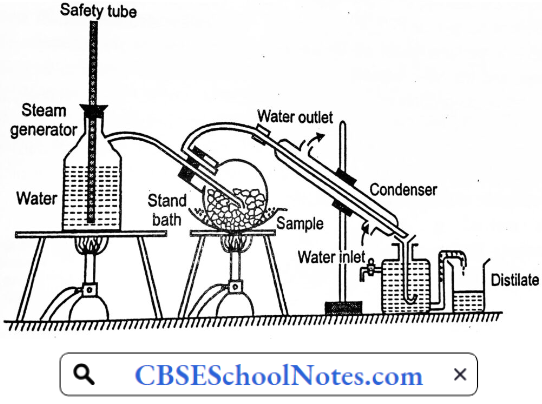
Steam Distillation Procedure:
The non-aqueous liquid is placed in the flask. A small quantity of water is added to it. Steam can is filled with water. The steam generator and the flask are heated simultaneously so that a uniform flow of steam passes through the boiling mixture.
- The mixture gets heated.
- The steam carries the volatile oil and passes into the condenser, which is cooled by cold water.
- The condensed immiscible liquid is collected into the receiver.
- Distillation is continued until all the non-aqueous liquid has been distilled. In the receiver, water and organic liquid form two separate layers, which can be easily separated using a separating flask.
- For volatile substances, which are miscible with water, distillation with steam would involve the same principle of fractional distillation.
Steam Distillation Applications:
- Steam distillation is used for the separation of immiscible liquids.
- This method is used for extracting most of the volatile oils such as clove, anise and eucalyptus.
- It is useful in the purification of liquid with high boiling point.
- Camphor is distilled by this method.
- Aromatic waters are prepared by this method.
Steam Distillation Advantages:
- Volatile oils can be separated at a lower temperature in steam distillation, without any decomposition and loss of aroma.
- If a substance has low volatility, it can be satisfactorily distilled, provided its molecular weight is considerably higher than water.
Steam Distillation Disadvantage:
Steam distillation is not suitable when immiscible liquid and water react with each other.
6. Molecular Distillation
Molecular distillation is defined as the process in which each molecule in the vapour phase travels the mean free path and gets condensed individually without intermolecular collisions on the application of a vacuum.
Molecular Distillation Principle:
The mean free path is the average distance travelled by the molecule in a straight line without any collision. The mean free path is inversely proportional to number of molecules to 1 cc of the gaseous phase.
- That means the mean free path can be increased by reducing the number of molecules per cc.
- The process is carried out at a pressure as low as 1 μhg.
- The number of molecules is drastically reduced and if a molecule is being heated under such conditions or pressure, the molecule escapes from the evaporating surface and travels a few cm without colliding with residual gas in the space above.
If a condensing surface is placed within this distance a major fraction of the molecule is condensed and will not return back to the distillant. Residual gas offers negligible resistance to the evaporation.
- The energy supplied for distillation is solely utilized to evaporate the compound and no energy is dissipated in the collisions.
- Therefore for a given temperature molecular distillation takes place at a very high rate or for a given distillation rate molecular distillation operates at a quite low temperature because the distillation travelled by the molecules is very short.
- It is also called short-path distillation.
- The distillate molecules should get a chance to reach the evaporating surface and therefore the layer of the distillate should be thin to overcome the pressure of the layer above to come to the surface (hydrostatic head).
- Therefore the distillant is maintained in a thin layer i.e., turbulent to provide best chance to the molecules to reach the surface.
- Vapour is evolved from the surface only and therefore is also called as evaporative distillation.
Molecular Distillation Applications:
- Purification of chemicals such as tricresyl phosphate, dibutyl phthalate and dimethyl phthalate.
- More frequently used in the refining of fixed oils.
- Vitamin A is separated from fish liver oil. Vitamin E is concentrated by this from fish liver oils and other vegetable oils.
- Free fatty acids are distilled at 100°C. Steroids can be obtained between 100 ’C and 200”C, while triglycerides can be obtained from 200 °C onwards.
- Proteins and gums Will remain as nonvolatile residues. Thus, the above molecular distillation.
7. Falling Film Molecular Still or Wiped Film Molecular Still
Falling Film Molecular Stil Principle:
In this method, vaporisation occurs from a film of liquid flowing down a heated surface under a high vacuum. The vapour (molecules) travels a short distance and strikes the condenser nearby. Each molecule is condensed individually. The distillate is subsequently collected.
Falling Film Molecular Stil Construction:
This consists of a vessel. This vessel has a diameter of one meter. The walls of the vessel are provided with suitable means of heating (jacket). Wipers are provided adjacent to the vessel wall. Wipers are connected to a rotating head through a rotor.
The condensers are arranged very close to the wall (evaporating surface). The vacuum pump is connected to a large diameter pipe at the centre of the vessel. Provisions are made for collecting the distillate and the undistilled liquid residue at the bottom.
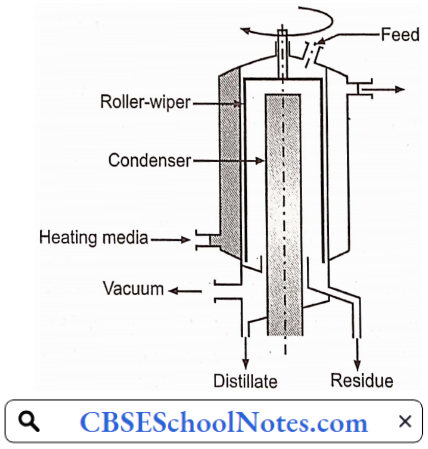
Falling Film Molecular Stil Working:
The vessel is heated by suitable means. Vacuum is applied at the centre of the vessel and wipers are allowed to rotate. The feed is entered through the inlet of the vessel. As the liquid flows down the walls, it is spread to form a film by PTFE (polytetrafluoroethylene) wipers, which are moving at a rate of 3 metres per second.
The velocity of the film is 1.5 metres per second. Since the surface is already heated, the liquid film evaporates directly. The vapour (molecules) travels its mean free path and strikes the condenser. The condensate is collected into a vessel. The residue (undistilled or mean free path not travelled) is collected from the bottom of the vessel and re-circulated through the feed port for further distillation. Capacity is about 1000 litres per hour.
8. Centrifugal Molecular Still
Centrifugal Molecular Still Principle:
In this method, liquid feed is introduced into a vessel, which is rotated at a very high speed (centrifugal action). On account of heating, vapourisation occurs from a film of liquid on the sides of the vessel. The vapour (molecules) travels a short distance and gets condensed on the adjacent condenser. Each molecule is condensed individually. The distillate is subsequently collected.
Centrifugal Molecular Still Construction:
It consists of a bucket-shaped vessel having a diameter of about 1 to 1.5 metres. It is rotated at high speed using 2 motors. Radiant heaters are provided externally to heat the fluid in the bucket. Condensers are arranged very close to the evaporating surface. The vacuum pump is connected to the entire vessel at the top. Provisions are made for introducing the feed into the centre of the bucket, for receiving the product and residue for re-circulation.
Centrifugal Molecular Still Working:
Vacuum is applied at the centre of the vessel. The bucket-shaped vessel is allowed to rotate at high speed. The feed is introduced from the centre of the vessel. Due to the centrifugal action of the rotating bucket, the liquid moves outward over the surface of the vessel and forms a film.
Since the radiant heaters heat the surface, the liquid evaporates directly from the film. The vapour (molecules) travels its mean free path and strikes the condenser. The condensate is collected into another vessel. The residue is collected from the bottom of the vessel and is recirculated through the feed port for further distillation.
Distillation Pharmaceutical Engineering Multiple Choice Questions
Question 1. Water for injection is prepared by using
- Simple distillation
- Fractional distillation
- Molecular distillation
- Steam distillation
Answer: 1. Simple distillation
Question 2. Which one of the methods is also called differential distillation?
- Simple distillation
- Molecular distillation
- Fractional distillation
- Steam distillation
Answer: 1. Simple distillation
Question 3. Which one of the following methods is used for distillation of camphor?
- Fractional distillation
- Steam distillation
- Simple distillation
- Molecular distillation
Answer: 4. Molecular distillation
Question 4. Which type of liquid evaporates first in the distillation process?
- Immiscible liquid
- Non-volatile liquid
- Less volatile liquid
- More volatile liquid
Answer: 4. More volatile liquid
Question 5. Which method we can use for the preparation of the aromatic spirit of ammonia?
- Simple distillation
- Molecular distillation
- Fractional distillation
- Steam distillation
Answer: 1. Simple distillation
Question 6. Which type of distillation is called as evaporative distillation?
- Simple distillation
- Fractional distillation
- Molecular distillation
- Steam distillation
Answer: 3. Molecular distillation
Question 7. Why condenser is placed in an inclined position?
- Collect the condensate easily
- Remove the film of condensed liquid
- To use the gravity principle effectively
- Fast condensation
Answer: 3. To use the gravity principle effectively
Question 8. Separation of liquid by distillation is based upon one of the following?
- Boiling point
- Miscibility
- Viscosity
- Vapour pressure
Answer: 3. Viscosity
Question 9. Mean free path is associated with
- Simple distillation
- Flash distillation
- Molecular distillation
- Steam distillation
Answer: 4. Steam distillation
Question 10. Complete separation of individual components is not possible in
- Simple distillation
- Molecular distillation
- Fractional distillation
- Steam distillation
‘Answer: 2. Molecular distillation
